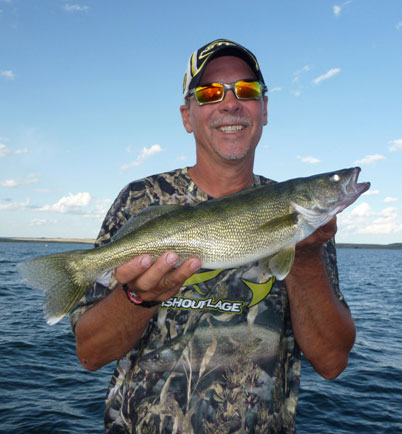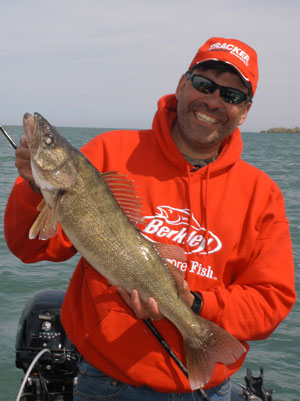Summer is finally here; at least the calendar says it is. It’s one of the most anticipated times of the year for many anglers, especially those, like us, that concentrate their efforts tangling with the elusive walleye. We’ve been living through a long winter, then a spring season of unstable weather, and the thought of spending the days fishing for walleyes under a warm summer sun are an inviting prospect to say the least.
 But while the idea of summer is a pleasant one, for a walleye angler, the reality is that this time of year – the transition period between spring and summer – can mean the real challenge is finding the walleyes. This is a time when virtually every presentation in your arsenal may be the right one on a given day. The walleyes are playing a game of “Hide and Seek” where you may find them on shallow flats, deep points, on weed lines or in open water. They can literally be EVERYWHERE! However, if you spend your time wisely and keep a couple key thoughts in mind, you can greatly up your odds for success this time of year.
But while the idea of summer is a pleasant one, for a walleye angler, the reality is that this time of year – the transition period between spring and summer – can mean the real challenge is finding the walleyes. This is a time when virtually every presentation in your arsenal may be the right one on a given day. The walleyes are playing a game of “Hide and Seek” where you may find them on shallow flats, deep points, on weed lines or in open water. They can literally be EVERYWHERE! However, if you spend your time wisely and keep a couple key thoughts in mind, you can greatly up your odds for success this time of year.
First and foremost (and we know you’ve heard us preach this before …), utilize your electronics to help you eliminate unproductive water and locate the areas with the best potential for success. Walleyes can be pretty easy to catch, but not always that easy to find. So finding them should always be the first priority. Fortunately, technology has progressed to the point that we now have the ideal set of tools for searching out and finding fish better and faster than we ever have in the past. For instance, when Lowrance came out with the HDS units a couple seasons back we all said “Wow!” Their HD color displays are so detailed and easy to read, and the features they provide add so much versatility and angler-friendly usability to these units that it made everything before them seem “antique”. This past year Lowrance took things a step further and introduced StructureScan™ Sonar Imaging and quite frankly, now that we have had a full year to learn to use this technology, we wonder how we ever got by without it.
StructureScan™ is a performance add-on option to the HDS units that enables anglers to scan both left and right (SideScan™) as well as straight down (DownScan™) with picture-like imaging sharp enough you’ll think you’re watching a video camera. The biggest advantage to this technology that we have found for walleye fishing is that it helps us in pinpointing key structures that may be holding walleyes. DownScan especially, is super useful when it comes to finding and identifying structural elements that in the past were tougher to interpret on a regular sonar image; fish holding structure like weeds, trees and rocks become child’s play!
Now once you have located fish, the fun really starts; figuring out the best way to catch them. If there is one thing we have learned over the years, especially in the early summer period, is that small is often better. First of all, consider what the walleyes are eating. Whether it’s minnows, perch, or whatever baitfish, it’s a new year’s crop, and these immature food sources will be small in size. So small bait offerings will be a better match to what the fish are foraging on. Secondly, the walleyes are not yet in their full-blown summer patterns, and not as active as they’ll be in a few weeks, so a smaller bait is more apt to get their attention. It’s sort of like those times when you’re hungry, but you don’t know exactly what you’re hungry for. You’re more apt to “nibble” than you are to sit down to a four-course dinner. Offering the walleyes a “snack” will prove more productive than laying out a full-meal-deal at this time.
So what’s the best “bite-sized” bait to use? That’s always the question, and the answer is familiar too … It depends on the fish’s location. If it’s a late spring, the walleyes could still be relating to shallow water cover in many lakes, so pitching small jigs would be a good choice. On some lakes the fish may be hanging on the edges of shallow to mid-depth flats, so slow trolling a bottom bouncer and small spinner set-up will catch plenty of walleyes.
In most cases however, if you’re after the biggest fish in the system, you’ll need to concentrate a bit deeper and key on fish that are related to, but not necessarily right on structure. That is to say, they could be on the outside edge of main-lake flats, or they may be suspended off the flats. You’ll need to cover some water to contact these fish consistently, so trolling is the way to go.
 It’s no secret that our “go-to” bite-sized crankbait is the Berkley Flicker Shad in the 5mm size. This little gem has caught us a ton of walleyes over the past few seasons. Later this year, Berkley plans to introduce 2 new sizes of Flicker Shads to the lineup adding 4 mm and 6 mm sizes. Combined with the already popular 5 mm and 7 mm sizes, this will give anglers a lot of great options with these lures.
It’s no secret that our “go-to” bite-sized crankbait is the Berkley Flicker Shad in the 5mm size. This little gem has caught us a ton of walleyes over the past few seasons. Later this year, Berkley plans to introduce 2 new sizes of Flicker Shads to the lineup adding 4 mm and 6 mm sizes. Combined with the already popular 5 mm and 7 mm sizes, this will give anglers a lot of great options with these lures.
When it comes to early summer trolling, we typically will use one of two techniques, Open Water trolling, or structure trolling. If we find the walleyes relating to the structure, like the edges of big flats or large main-lake points, we’ll troll using long rods and a no-stretch line like Berkley FireLine in 10 pound test. From the first time we used FireLine for this application we noticed how easy it was to monitor the baits. You could tell instantly when the lures were hitting bottom, and when they were running true, their vibration telegraphed right up the line so you could see the rod tip vibrating. If the lure picked up debris and stopped working, it was immediately noticeable, alerting you to reel in and clean the lure.
The long rods are another tool we found to be very helpful in this scenario. Normally when we want to spread out our trolling patterns, we’ll use an in-line board like Off Shore Tackle’s OR-12 Side Planers. However, in many, if not most contour trolling situations, we’re running lures very tight to the bottom where picking up debris or getting snags is inevitable. If you’ve ever had to deal with these sorts of things when using boards you know it can really wreak havoc with your fishing fun. Also, when contour cranking, the object is to keep the baits close to the contour you’re running and going “boardless” makes that easier. Working with the fishing rod design team at Bass Pro Shops we were able come up with a trolling rod that fits the bill perfectly. A 12 foot medium action rod with just the right action we were looking for. The rod is stiff enough to spread a lure out away from the boat, yet has a soft enough tip section that it’s ideal for fighting in big fish. It’s also sensitive enough to make it easy to read whether the crankbait is running clean, or if it’s picked up debris off the bottom and is fouled. The rod is a 2-piece design, making storage simple, and it features a foam handle which holds up better for use in rod holders compared to cork.
Of course, when the walleyes ARE off the structure and cruising open water, then the typical “board trolling” tactics come into play, and then the Off Shore Tackle Side Planers are invaluable for allowing you to cover water and contact more fish. It’s all a matter of using the right presentation for the situation at hand.
So as you hit the water this time of year, keep in mind that the walleyes could be virtually anywhere and catchable with a variety of tactics. The task then is to play a good game of “Hide and Seek”, search them out and put a plan together that will catch ‘em in the most effective manner for that day. That’s how you get The Next Bite.










